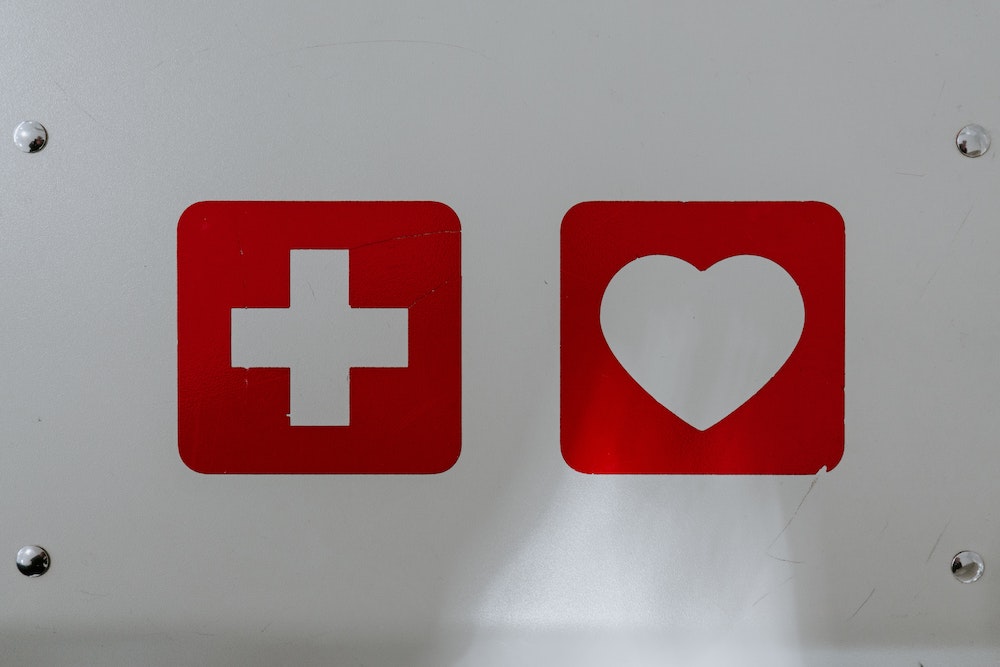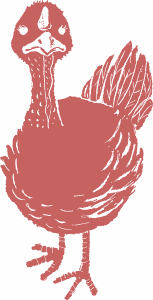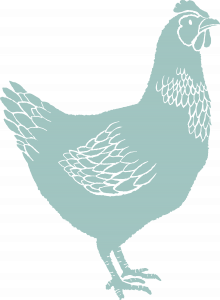
Resource Acknowledgement
The following resource was written for The Open Sanctuary Project by guest contributor Jill Tedeschi of Healthy Herd Consulting.
Every second during a resident health emergency matters. Having the correct supplies and tools at your fingertips may be the difference between life and death for the individuals in your care. In this resource, we’ll provide a list of supplies to have on-hand for resident chicken-, turkey-, duck-, goose-, goat-, sheep-, alpaca-, llama-, pig-, horse-, donkey-, and cow-health emergencies.
This list is just a starting point. Consult with your veterinarian for their opinion on the best drugs and supplies to have for your particular residents and receive clear instructions on when and how to use all medications. Often, the benefit of having drugs and supplies on hand is that it allows your veterinarian to talk you through starting a particular treatment if they cannot examine the individual right away or if the situation is so urgent that they want you to administer medication or treatment immediately while they’re en route.
How To Use This Supply List
This healthcare supply list is broken down into ten digestible sections. Each section is broken down further by species grouping or a specific trait. The ten sections are:
- Organizational Supplies
- Small Instruments
- General Supplies, First Aid, & Small Tools
- Cotton, Gauze, Pads, Bandages, & Wrap Supplies
- Topical Sprays, Creams, & Ointments
- Hoof, Foot, & Leg Care
- Medications & Supplements
- Needles & Syringes
- Additional Supplies for Neonates
- Additional Considerations for Recumbent & Acutely Non-Ambulatory Residents
Downloadable Version Available!
This checklist is also available for download in an abbreviated, printable format which can be found here!
Financial Considerations
The quantity of supplies you need depends on the size of your resident population and how quickly you go through supplies. Building your emergency first aid kit from scratch is no small financial commitment. Neither is keeping it refreshed and restocked as medications are used or expire. Connect with your vet to determine the appropriate quantities to keep on hand, and be sure to have a schedule in place to check medication expiration dates.
Building Trust With Your Veterinarian
There is a chance your veterinarian may not be comfortable with leaving prescription medications and medical supplies to have “just in case.” This might be particularly true if this is a vet service you recently started using and there is no precedent or history. Be sure that you have vetted your vet and determined they are the best fit for the residents in your care. Continue to build and maintain a good relationship, established on trust and honest communication. As your relationship grows, you may find that they are more open to leaving medications for you to administer under their guidance. As a general rule, having a competent vet who will guide you during an emergency and provide high-quality care to your residents is better than an absent, less-involved vet who will leave you prescriptions.
What This List Does Not Include
Please note, this supply list does not cover the myriad of non-healthcare emergencies that may occur with your residents. Other resident emergencies to be prepared for include fire, evacuation, escaped or missing residents, broken gates and fences, and more.
This list also does not cover laboring individuals. If you rescue a pregnant resident, be sure to talk to your veterinarian about what supplies you should have on hand and work with them to put a plan in place should she need assistance during labor.
Organizational Supplies
All Species
- Clearly labeled cabinets or totes to hold the supplies- When time is of the essence and your adrenaline is running high, you must quickly find the necessary supplies to help the resident in need. You may need to verbally direct someone less-familiar with your supplies to collect items for you from these labeled totes or cabinets.
- Designated bucket, tote, or bin to take supplies with you into the field- Having a bucket or tote for the supplies helps keep you organized during the emergency and provides a place to temporarily put trash or used needles, so they are not lost.
- Method of note-taking- Whether a pad of paper and pen or your phone’s notes app, writing down instructions from your vet or observations ensures the residents receive the correct treatment, and you can update their health records accurately.
Small Instruments
All Species
- Forceps (tweezers)
- Penlight and/or headlamp
- Stethoscope
- Suture scissors
- Tissue scissors
- Bandage scissors- Bandage scissors have a blunted end to the lower blade. Although pricey, Miltex’s 5” fluoride-coated nurse’s scissors are a favorite among sanctuary operators for their ease of use and blade sharpness.
- Scalpel & holder
All Mammals
- Thermometer & lubricant for taking rectal temperatures
Horned & Tusked Residents
- Gigli saw with extra wire & wire cutters
General Supplies, First Aid, & Small Tools
All Species
- Blow dryer- Handy if a wet resident needs to be dry and warm quickly.
- Hydrogen peroxide
- Isopropyl alcohol- Great for quick cold sterilizations, flattening hair or feathers, and emergency cool-downs.
- Replacement fluids such as 1L bags of lactated rings, plasma lyte, or saline- Your vet may guide you in administering fluids to dehydrated individuals and can recommend which types(s) to have on hand for your residents.
- Mineral oil- Often used for lavages and enemas.
- Molasses, applesauce, peanut butter, fruit, or other safe treat to add to oral medications or hold pills and improve their taste
- Nitrile or latex gloves, non-sterile
- Nitrile or latex gloves, sterile
- Oxygen & method of administration- If logistically and financially possible, having oxygen available allows you to respond to a resident in respiratory distress while awaiting further veterinarian instruction or attention.
- Plastic sealable baggies, quart-sized- These bags are great for collecting fecal samples or any other irregular item during an emergency that you’d like to examine later.
- Safety goggles
- Saline solution, 0.9% non-sterile bottle- This saline is frequently called physiological or irrigation saline and may be used in situations where sterility is not required.
- Saline solution, 0.9% sterile bags or bottles- This saline might be used as subcutaneous or IV fluid administration or make smaller 10 mL sterile syringes.
- Saline solution, 0.9% sterile 10 mL syringes – These saline syringes may be particularly helpful for flushing sensitive areas that call for sterility, such as the eyes.
- Sample-collection swabs and sterile containers
- Spray bottles- Great for decanting other topicals and solutions into. Be sure they are appropriately and clearly labeled, like with NFPA Diamond Labels for OSHA compliance.
- Sterile lubricant- Lubricant is listed in Small Instruments for taking rectal temperatures, but your veterinarian may instruct you to use lubricant in other applications for all species, such as for reducing prolapses.
- Styptic agents- Styptic agents stop bleeding and come in various formulas and applications, including Yunnan Baiyao, styptic sticks, and powders such as Kwik Stop and Wonder Dust.
- Sugar- Helpful for shrinking tissue when mixed with an appropriate medium and applied under veterinary direction.
- Surgical, skin-safe glue
- Identification measures
- Wound antiseptic solution- Speak with your vet about which antiseptic solutions are appropriate and safe for each species. These solutions might include diluted povidone-iodine or diluted prescription Chlorhexidine 2%.
- Tongue depressors
- Ice packs
- Funnel
All Birds
- Nebulizer & chamber
- Tube feeding and/or syringe feeding supplies including critical care, appropriately-sized feeding tubes, syringes, and oil lubricant
Proper Training Is A Must!
Tube feeding is something that should only be done by someone with experience tube feeding birds. If done incorrectly, there could be devastating consequences. Even syringe feeding comes with the risk of aspiration if done incorrectly and should be demonstrated by an experienced caregiverSomeone who provides daily care, specifically for animal residents at an animal sanctuary, shelter, or rescue..

All Mammals
- Coat clippers & extra size 10 blades- This style of hair clippers is not intended for complete coat removal. Instead, they are helpful when removing a small portion of a resident’s coat to gain better access to their skin for treatment.
- Method of restraint, including appropriately-sized halters, lead ropes, or a soft rope snare
- Urinalysis pH testing strips & urine collection cups
Goats, Sheep, Alpacas, & Llamas
Cotton, Gauze, Pads, Bandages, & Wrap Supplies
All Species
- Abdominal (ABD) pads, sterile- These large, thick, absorbent pads may be helpful on large wounds or where extra padding is needed.
- Cast padding, 2”
- Cast padding, 4”
- Cohesive wrap, 1”
- Cohesive wrap, 2”
- Cohesive wrap, 4”
- Cotton gauze squares, 4×4” non-sterile
- Cotton gauze squares, 4×4” sterile
- Cotton-tip applicators, 6” non-sterile
- Cotton-tip applicators, 6” sterile
- Duct tape
- Elastikon tape, 1”
- Elastikon tape, 2”
- Elastikon tape, 4”
- Hypafix dressing retention tape 2”
- Hypafix dressing retention tape 4”
- Kerlix-style rolled gauze, 2”
- Kerlix-style rolled gauze, 4”
- Lightweight, padded splinting material, such as SAM splint
- Medical tape, 1”
- Non-adherent (Telfa) pads, sterile- Rather than purchasing a variety of sizes, you may prefer to buy 3×4” pieces and cut them to size while still in their sterile paper wrapper.
- Poultice- Animalintex brand poultice pads are available in a variety of sizes and shapes.
- Rolled gauze, 1”
- Rolled gauze, 2”
- Rolled gauze, 4”

Cast Padding, Kerlix, Or Rolled Gauze?
All three are cotton-, cotton-poly, or synthetic-based conforming bandages and have varying thickness, cushion, absorbency, and texture. Typically, cast padding provides the most cushion, followed by Kerlix, then rolled gauze. Each has its specific application; connect with your veterinarian about which would be appropriate and when.
Chickens And Turkeys
- CropA crop is a pouched enlargement of the esophagus of many birds that serves as a receptacle for food and for its preliminary maceration. bras or supplies to fashion your own crop bra
Topical Sprays, Creams, & Ointments
All Species
- Antifungal treatments- Check with your veterinarian about which topical (or oral) antifungals are appropriate for each species you care for.
- Antibacterial & antimicrobial ointments- Aside from over-the-counter triple antibiotic ointment and Vetericyn Plus, check in with your vet if prescription-based Silver Sulfadiazine Cream 1% (SSD) would be appropriate to have. Ask if there are any other antibacterial and antimicrobial healing ointments they recommend.
- DermatitisDermatitis refers to skin irritation. This may include itchy, dry skin or a rash on swollen, reddened skin. It may also cause the skin to blister, ooze, crust or flake treatments- Dermatitis, a general term described as skin irritation, afflicts each species differently. Be sure to connect with your vet about the more common skin ailments for each of the species you care for and which topical ointments or sprays you should keep on hand.
- Drawing salve, such as ichthammol- These salves may be helpful to draw out infections, abscesses, or treat other skin disorders.
- Fly-deterring ointment and spray for around or on wounds- Be sure to check if the fly-deterrent is safe for open wounds or if it can only be applied to unbroken skin.
- Ectoparasite treatments, external application- Ask your veterinarian about what appropriate topical sprays, pour-on, or dust you should keep in stock in case of external parasites.
- Pain-relieving ointment or gel- Helpful in treating arthritis and acute conditions. Ask your veterinarian which pain-relieving topicals are appropriate for your residents.
- Skin-protecting ointment, salve, or jelly such as A&D, Vaseline, or petroleum-free alternative
- Wound spray- There are many applications for aerosol-based dressings such as antiseptic and antifungal Blu-Kote and liquid barrier Alushield. Speak with your vet to understand which wound sprays are appropriate for each resident and in what context.
All Birds
- Topical treatment to respond to prolapsethe falling down or slipping of a body part from its usual position or relations such as hemorrhoid cream
Hoof, Foot, & Leg Care
All Species
- Dremel with appropriate attachments- You might find a Dremel or other grinding tool more appropriate for trimming nails or hooves (or beaks) or smoothing out cracks. Ensure you’re properly trained by your vet or farrierSomeone who provides hoof trimming and care, especially for horses or cows and have the proper attachments before you attempt to use it on a resident.
- Foot soaking materials- This includes Epsom salt and a soaking boot or alternative method.
All Birds
- Bumblefoot treatment- Create a plan with your vet about how you plan to address bumblefoot with your residents, when to intervene, and how you should treat the lesion.
- Nail clippers
All Mammals
- Hoof rot & thrush treatment- Ask your veterinarian which topical treatments they recommend, such as Hoof ‘n’ Heel, Thrush Buster, and prescription antibiotic suspensions and powders.
- Hoof nippers
- Hoof shears, 4”
- Liquid hoof bandage, such as Kopertox or Pritox
Cows, Horses, & Donkeys
- Hoof knife
- Hoof pick
- Hoof file
Horses And Donkeys
- Leg wraps
- Leg padding/ leg cottons/ gamgee cloth
- Ice boots
- Disposable diapers
Medications & Supplements
Veterinary Guidance Is Imperative!
We said this above, but it bears repeating- be sure to consult with your veterinarian for their opinion on the best drugs and supplies to have for your particular residents and receive clear instructions on when and how to use all medications. All medications should be administered under the guidance of a veterinarian.

All Species
- Antibiotics, injectable and/or oral- Ask your veterinarian which broad-spectrum, species-specific antibiotics to keep on hand.
- Antihistamines- Speak with your veterinarian about which antihistamines are appropriate for your residents and how and when to administer them.
- Apple cider vinegar- ACV has a wide range of applications in sanctuary healthcare. Ask your veterinarian when it’s appropriate and how to administer it.
- Bronchodilator- Bronchodilators help open the airways when a resident is in respiratory distress. Connect with your vet if any would be appropriate to have on hand.
- Diuretics- Connect with your vet about the benefits of diuretics for treating conditions such as congestive heart failure and if it would be appropriate to keep it on site.
- DewormingThe act of medicating an animal to reduce or eliminate internal parasites, either prophylactically or in response to illness. agents & method of administration- Each species has its unique parasitic challenges. Create a deworming plan and supply list with your veterinarian.
- Electrolytes, species-appropriate
- Emergency treatment for shock- Shock has many causes and affects each of the species differently. Ask your vet if it’s appropriate to have medication to treat acute shock on hand.
- Emergency sedation- Your vet might deem it appropriate for you to have a dose of emergency sedation on hand if a resident is in danger of hurting themselves physically or psychologically from overactivity.
- Ophthalmic ointments & solutions- Not all ophthalmic ointments and solutions are appropriate for every ocular malady. Ask your veterinarian if you should have prescription triple antibiotic ophthalmic ointment and solution in stock and how to administer each.
- Pain medication, injectable and/or oral- Connect with your veterinarian about which pain medications are safe to administer and combine with your residents to provide them both acute and chronic relief.
- Probiotics, species-specific
- Universal antidote, activated charcoal- Life-saving activated charcoal comes in both suspensions and tablets. Connect with your vet about which would be the most appropriate to keep in stock for your resident population.
- Vitamin supplementation, oral and/or injectable- Each species is prone to different vitamin deficiencies. Ask your veterinarian which vitamins you should keep on hand for the species you care for.
All Mammals
- Epinephrine- Ask your veterinarian if it’s appropriate to have a bottle of emergency epinephrine and if they will train you on when to administer this life-saving drug during anaphylaxis.
- Gastric protectant & ulcer treatment- Ask your veterinarian about which gastroprotection and treatment may be appropriate for your residents, especially if they are on NSAIDs.
- Tetanus antitoxin- Ask your veterinarian if you should have tetanus antitoxin on hand in case of suspected tetanus clostridial infection with a resident.
- Urolithiasis & urinary discomfort treatment- Connect with your vet about how to address urolithiasis or urinary discomfort in your male residents. They might recommend keeping ammonium chloride granules and phenazopyridine hydrochloride (pain reliever specific to the urinary tract) tablets in stock.
- Steroids, injectable and/or oral- Ask your veterinarian if having injectable or oral steroids to reduce acute inflammation is appropriate for your resident population.
Goats, Sheep, Cows, Alpacas, & Llamas
- Bloat treatment(s) & method of administration- Talk to your vet about supplies to have on hand so they can talk you through responding to free-gas bloat and frothy bloat if necessary. They might suggest having an appropriately-sized stomach tube, lubricating oil, ToxiBan, and an emergency trocar or cannula, as well as frothy bloat treatments such as Rumen-Eze or Therabloat.
- Selenium, injectable- Vital to treating white muscle disease and maintaining proper muscle function, ask your vet about keeping a bottle of injectable selenium (Bo-Se or Mu-Se) on site.
- Thiamine injectable- Ask your veterinarian about keeping injectable thiamine on hand in case of suspected polioencephalomalacia in a resident.
Horses & Donkeys
- Sea salt, salty snacks, or water consumption aid- Helpful if your vet instructs you to increase water intake in fear of dehydration or colic.
- Supplies to respond to colic– Talk to your vet about the supplies they recommend you have on hand in case of colic. This may include tubing, magnesium sulfate, and psyllium.
Needles & Syringes

Do I Really Need All These Syringes And Needles?
If you care for multiple species of varying sizes, the syringes and needles listed below will ensure you and your residents will be ready for whatever style, volume, and viscosity of liquid your residents need. Sanctuaries that only care for one species or a few species of a similar size may not require the entire range of sizes listed below. Ask your veterinarian which would be most appropriate for your resident population.
All species
- Catheter-tip oral syringes, 1 mL
- Catheter-tip oral syringes, 3 mL
- Catheter-tip oral syringes, 6 mL
- Catheter-tip oral syringes, 10 mL
- Catheter-tip oral syringes, 60 mL
- Luer-lock or Luer-slip sterile syringes, 1 mL
- Luer-lock or Luer-slip sterile syringes, 3 mL
- Luer-lock or Luer-slip sterile syringes, 6 mL
- Luer-lock or Luer-slip sterile syringes, 10 mL
- Luer-lock or Luer-slip sterile syringes, 60 mL
- Needles, 16g x 1”
- Needles, 18g x 1”
- Needles, 20g x 1”
- Needles, 22g x 1”
- Needles, 23g x ¾“ or 1”
- Needles, 25g x ¾“ or 1”
- Needles, winged infusion set 18g x ¾“ or 19g x ¾“- Winged infusion sets provide some flexibility in the syringe’s position while in use. Speak with your veterinarian about when these shorter needles with a flexible hose might be appropriate and how to use them.
- IV administration line- IV lines can be especially helpful when you are instructed to give large volumes (500 mL or more) of subcutaneous or rectal fluids.
Luer-Lock vs. Luer-Slip
Luer-lock syringes are designed so that the needle twists and locks onto the end of the syringe, whereas a Luer-slip syringe does not lock onto the needle. Medical professionals prefer one over the other depending on the task at hand, but for subcutaneous and intramuscular injections, you may find that the Luer-lock syringe is your best bet. When using a Luer-slip to administer medication through a small needle, it is easy to create so much pressure that the needle detaches from the syringe, spraying medication all over the place. This shouldn’t happen with a Luer-lock syringe.
Additional Supplies
Talk to your veterinarian about additional supplies that can aid in the administration of injections, particularly for individuals who are difficult to easily or safely restrain. For large mammals, this may include devices such as a pole syringe (which allows you to administer an injection while still keeping distance, and possibly even a physical barrier, between you and the individual) or a “Slap-Shot” (which adds a line of flexible tubing between the needle and injection, allowing for more movement of the individual without risking the needle breaking off the syringe). Make sure staff are trained on when and how to properly use any additional supplies you and your veterinarian decide to keep onsite.
Additional Supplies for Neonates and Young Individuals
All Species
- Feeding tube and oil lubricant- Never attempt to tube feed any individual, particularly a young or neonatal resident, without training and instruction from your veterinarian.
- High-density nutritional oral supplement- Your veterinarian might recommend supplementing a neonate with high-density nutrition, like species-specific Nutri-Drench.
- Blankets and towels
- Safe heat source
Neonatal & Young Mammals
- Antidiarrheal agent
- Feeding supplies such as pans, bottles with appropriate teats, & bottlebrush
- Bulb syringe for clearing airways
- Colostrum replacement
- Milk or milk replacer
- Naval dip or spray
- Newborn coats
- Umbilical clamps
Additional Considerations For Recumbent And Acutely Non-Ambulatory Residents
Resident emergencies where the individual is stuck in a recumbent position or found acutely non-ambulatory are particularly challenging to navigate. Improper handling of recumbent and non-ambulatory residents and misuse of equipment may risk further harmThe infliction of mental, emotional, and/or physical pain, suffering, or loss. Harm can occur intentionally or unintentionally and directly or indirectly. Someone can intentionally cause direct harm (e.g., punitively cutting a sheep's skin while shearing them) or unintentionally cause direct harm (e.g., your hand slips while shearing a sheep, causing an accidental wound on their skin). Likewise, someone can intentionally cause indirect harm (e.g., selling socks made from a sanctuary resident's wool and encouraging folks who purchase them to buy more products made from the wool of farmed sheep) or unintentionally cause indirect harm (e.g., selling socks made from a sanctuary resident's wool, which inadvertently perpetuates the idea that it is ok to commodify sheep for their wool). to the individual and, depending on their size, could endanger the human helpers. This section provides a few examples of supplies to keep on hand to help relocate or support the individual. However, be sure to connect with your veterinarian for training and to create a game plan if any size resident, from 3 lbs to 3,000 lbs, needs immediate assistance.
All Birds And Small Mammals (Less Than ~100 lbs / 45 kg)
- Towels & blankets
- Appropriately-sized carriers- The bottom half of a sturdy large carrier may be helpful for non-ambulatory large-breed birds and potbelly pigs.
- Safe, sturdy material to place next to the individual if they need support to stay sternal, such as straw or hay bales. This may also include a supportive sling, cart, or padded nest for birds.

Non-Ambulatory Chickens
For more information on the care of non-ambulatory chickens, check out our in-depth resource, here.
Mid-Size & Large Mammals
- Multiple people
- Towels, blankets, & sheets
- Safe, sturdy material to place next to the individual if they need support to stay sternal, such as straw or hay bales. This may be a round bale or a 1-ton rectangular bale for cowsWhile "cows" can be defined to refer exclusively to female cattle, at The Open Sanctuary Project we refer to domesticated cattle of all ages and sexes as "cows." and horses.
- Species-specific halters and lead ropes
- Webbing, sturdy nylon rope, & ratchet straps
- Rescue glide- Rescue glides are lightweight, plastic backboards you place under large animals in order to help move them to a new location or even load them up a ramp into a trailer to drive to receive medical treatment.
- Appropriate method of lifting large-sized resident to standing- This may include a sling or hip lift. Some methods may need a tractor, hook, and heavy chains in order to aid the resident.
- Temporary shade structure- In the event that the individual cannot be moved right away, it’s helpful to have supplies on hand to provide temporary protection from the elements. This may include tarps, shade cloth, and posts.

A Note About Lifting Equipment For Cows
Some equipment designed to lift and support cows may not work for sanctuary residents. For example, a hip lift is unlikely to fit an older male Holstein. We recommend working with your veterinarian to find equipment that would work for even your largest resident.
SOURCES:
Llama And Alpaca Car, First Edition | Cebra, Anderson, Tibary, Van Saun, And Johnson (Non-Compassionate Source)
Alpaca Health Care | Island Alpacas (Non-Compassionate Source)
Dealing With A Down Horse | The Horse (Non-Compassionate Source)
Non-Compassionate Source?
If a source includes the (Non-Compassionate Source) tag, it means that we do not endorse that particular source’s views about animals, even if some of their insights are valuable from a care perspective. See a more detailed explanation here.








